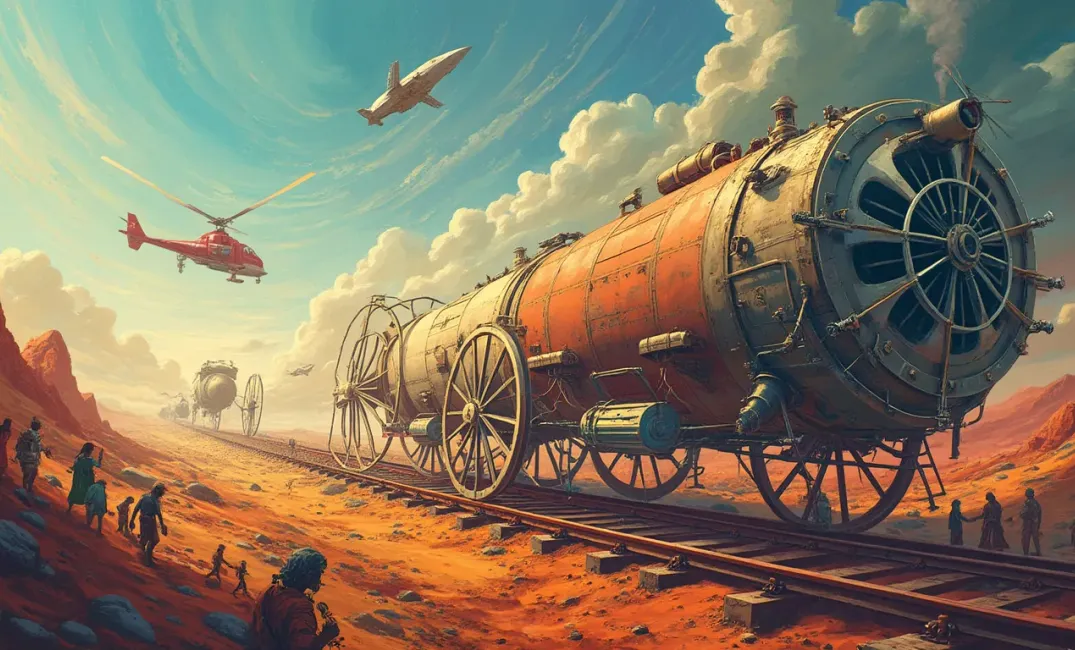Introduction: The Journey of Human Mobility
Throughout history, transportation has been the vehicle of human progress, innovation, and exploration. This entry delves into the legacy of human transportation, tracing the development of different transportation modes—each representing a pivotal moment in human history. From the humble origins of foot travel to the complexities of space travel, transportation connects humanity across time and spaces, embodying the relentless pursuit of movement, connection, and discovery.
"Transportation is the thread that weaves together the fabric of human civilization, binding disparate worlds and forging pathways of transformative change." — *Author Unknown*
The Dawn of Movement: Early Human Mobility
Primitive Pathways and Nomadic Origins
- Pedestrian Beginnings: The earliest form of transportation was foot travel, laying the foundation for migration, exploration, and trade. Human migration patterns illustrate the significance of foot travel in spreading cultures, languages, and technologies across continents.
- Domestication of Animals: The domestication of animals such as horses, camels, and oxen revolutionized transportation. These animals facilitated the emergence of nomadic societies and enabled more efficient travel over long distances, enhancing trade and cultural exchange.
The Advent of the Wheel
- A Revolutionary Invention: The invention of the wheel around 3500 BCE marked a significant technological leap, leading to the development of carts and chariots. This innovation reduced the physical burden of transportation, enhancing efficiency and expanding trade networks.
- Impact on Ancient Civilizations: Civilizations like Mesopotamia, Egypt, and the Indus Valley thrived by utilizing wheeled vehicles for agricultural, military, and trade purposes, demonstrating the wheel's transformative impact on human society.
Navigating the Waters: The Evolution of Maritime Transport
The Age of Exploration
- Early Seafaring Innovations: Ancient mariners crafted vessels like canoes and rafts, enabling the exploration and colonization of new lands. These early boats laid the groundwork for complex maritime trade and cultural exchanges.
- The Golden Age of Sail: The development of sailing ships in the Age of Discovery expanded the boundaries of known worlds. Navigators like Columbus, Magellan, and Zheng He embarked on voyages that connected disparate continents, driving global trade and exchange.
The Rise of Steam and Modern Shipping
- Steam Power and Industrialization: The steam engine revolutionized transportation, heralding a new era of merchant and passenger ships traveling predictable routes and schedules. It facilitated global commerce and ushered in an era of unprecedented connectivity.
- Containers and Logistics: The advent of containerization in the mid-20th century optimized shipping logistics, standardizing and streamlining global trade processes. It transformed supply chains, contributing significantly to contemporary globalization.
Land Anew: The Evolution of Rail and Road Transport
Railways and the Industrial Transformation
- The Birth of Rail Transport: The 19th-century railroads, propelled by steam locomotives, transformed landscapes and societies, enabling efficient movement of goods and people. Rail networks underpinned industrial growth and urbanization.
- Expansion and Connectivity: Railroads fostered economic development by linking remote areas, facilitating migration, and connecting national markets. They have become integral infrastructure for nations, revolutionizing travel and commerce.
Automobiles and the New Era of Mobility
- Automobile Development: The invention of the automobile in the late 19th century democratized personal transportation. Innovations by pioneers like Henry Ford made cars accessible to the masses, shaping urban landscapes and travel behaviors.
- Highways and Infrastructure: The rise of extensive highway networks in the 20th century transformed mobility, enabling suburbanization, influencing economic growth, and reshaping socioeconomic and environmental landscapes.
Taking to the Skies: The Advent of Air Travel
Pioneering Aviation
- Early Flight and Invention: The Wright brothers' successful powered flight in 1903 unveiled the potential of aviation. Their achievement catalyzed rapid development in aircraft technology, transforming transport, commerce, and warfare.
- Commercial Aviation's Rise: The post-World War II era heralded the growth of commercial aviation, making air travel accessible and reshaping global connectivity. Airlines and jet engines revolutionized travel, reducing distances and time across continents.
The Future of Air Mobility
- Sustainable Aviation: Innovations like electric and hydrogen-powered aircraft promise to address aviation's environmental impact, aligning industry growth with ecological sustainability goals.
- Urban Air Mobility: Emerging technologies like drones and air taxis hold the potential to redefine urban transportation, offering new solutions for congestion and reconceptualizing urban infrastructure.
Beyond Earth: The Frontier of Space Transport
The Space Race and Beyond
- Humanity's Leap into Space: The 20th century witnessed humanity's venture into space, driven by geopolitical, scientific, and exploratory aspirations. Landmark missions like Apollo 11 epitomized human ingenuity and technological prowess, marking a new frontier of transportation beyond Earth.
- International Space Collaboration: Contemporary space initiatives exemplify a global collective spirit, with organizations like Elon Musk's SpaceX and NASA leading interplanetary exploration efforts, pushing the boundaries of human reach.
Space's Role in Future Transportation
- Interplanetary Travel Aspirations: Space transport innovations explore the potential of colonizing other planets, offering alternative avenues for sustaining human civilization and inciting discussions about humanity's place in the cosmos.
- Technological Spinoffs: The space sector's advancements produce spin-off technologies that benefit terrestrial transportation, leveraging innovations in materials science, propulsion, and digital systems.
Conclusion: The Infinite Road Ahead
Human transportation is both a vessel and a vision—one that spans epochs and embodies the relentless drive to explore, connect, and transcend. These transportation innovations mirror humanity's transformative journey and continually mold societies, economies, and cultures, drawing new contours of progress.
As we navigate the infinite road ahead, transportation remains key to addressing global challenges and opportunities, ensuring connectivity, reducing environmental impacts, and fostering innovation. Let us harness the power of movement with foresight, ensuring that the legacy of transportation continues to enrich global connectivity within a framework of sustainability, equity, and advancement.
"In the endless journey of discovery, transportation is both our compass and carriage, steering us through vast landscapes of imagination and possibility." — *Author Unknown*
INNOVATION, HISTORY, EXPLORATION, CONNECTIVITY, MOBILITY, CIVILIZATION, FUTURE, SPACE TRAVEL, GLOBALIZATION, TRANSPORTATION

